OCZ Vertex 4 Review (256GB, 512GB)
by Anand Lal Shimpi on April 4, 2012 9:00 AM ESTInside the Vertex 4
At a high level, Everest 2 is architecturally very similar to its predecessor. The SoC is still built on a 65nm G process and maintains the same basic architecture. Clock speeds are up now from 333MHz to 400MHz. There are also microarchitectural tweaks at work here – limits in Everest 1 have since been removed for Everest 2. Everest 2's sequencer is much improved, but getting more detail than this is basically impossible.
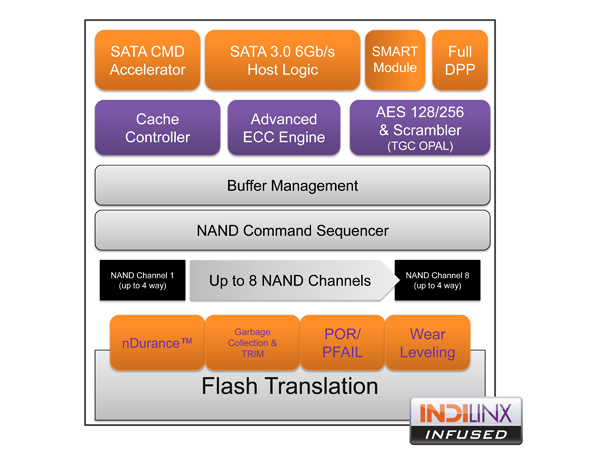
Everest 1's Block Diagram, Similar to Everest 2
Just as with previous OCZ drives, the Vertex 4 ships with its own custom designed PCB. Unlike most SSDs we've seen, the Vertex 4 places its Everest 2 controller in the center of the PCB – with NAND fanning out in a circle around it. The Indilinx SoC uses the drive housing as a heatsink as two thermal pads help conduct the heat away from the chip:
In the 512GB version we find quad-die packaged Intel 25nm synchronous MLC NAND devices, sixteen of them in total. The 256GB version keeps the same number of devices but drops the die count per package from 4 to 2. Despite launching with Intel NAND, OCZ claims broad support for Flash from other vendors. Touting that advantage really only matters if there's cheaper NAND available on the market, today Intel NAND is still priced competitively enough to make it an obvious fit.
OCZ is currently testing 20nm Intel NAND and 24nm Toggle Mode NAND with the Everest 2. Both are functional at this point, but neither is optimized in the current firmware. Should Toggle Mode NAND pricing or performance offer a measurable advantage, OCZ will introduce a separate product based on it. Currently, low-density 24nm Toggle NAND isn't price competitive and thus it's not used at launch. OCZ did add that a 1TB Vertex 4 would almost certainly use Toggle NAND as Toshiba's high-density pricing (64GB, octal die packages) is better than from IMFT these days. We're still at least a quarter away from seeing 20nm NAND used in volume, so enabling support for either of these options will require a firmware update.
With its sights fixed on OEMs, OCZ is far more concerned about drive longevity than it once was. OEMs don't like having to re-qualify components, they want a steady supply of the same product for the lifespan of whatever system they're selling. If a system is shipping to a government buyer, that lifespan can be extremely long. As a result, OCZ wanted to build a controller that was as forward looking as possible. Everest 2 needed to be able to migrate to 20nm without requiring another qualification pass from OCZ's customers. As NAND cell sizes shrink, error rates go up. Only so much can be dealt with at the NAND factory, the controller is extremely important to maintaining data validity.
The original Octane could correct up to 78 random bits for every 1KB of data using its BCH ECC engine. While that was more than sufficient for 25nm NAND, OCZ is planning for the future with Everest 2 and implemented a more robust ECC engine capable of correcting up to 128 random bits for every 1KB of data. OCZ believes the Everest 2's ECC capabilities are enough to ensure reliable operation with 20nm IMFT NAND and perhaps the first 1x-nm IMFT NAND as well. For consumers however, this has no bearing on the Vertex 4's performance/reliability as a drive today (Octane's ECC engine was enough).
1GB of DDR3-800 On-Board
The Everest 2 controller is flanked by a 512MB Micron DDR3-800 DRAM. Another 512MB chip exists on the flip side of the PCB bringing the total to a whopping 1GB of DDR3 memory on-board. OCZ makes no effort to hide the DRAM's purpose: Everest 2 will prefetch read requests from NAND into DRAM for quick servicing to the host. When serviced from DRAM, reads should complete as fast as the interface will allow it – in other words, the limit is the 6Gbps SATA interface, not the SSD.
In order to get 128GB, 256GB and 512GB drives to market as quickly as possible, OCZ is shipping them all with 1GB of DRAM on-board. The 128GB and 256GB drives simply won't use all of the DRAM however. A future revision of the Vertex 4 will pair the 128/256GB drives with 512MB of memory instead to save on costs.
The amount of memory bandwidth offered to the Everest 2 controller is insane – we're talking about 3.2GB/s, as much as many modern day smartphone SoCs, and as much as a desktop PC had a decade ago.
OCZ wouldn't tell me if the costs of shipping 1GB of DDR3 memory outweigh the savings from not having to pay SandForce for silicon anymore. Even though it owns Indilinx, R&D and manufacturing aren't free. All of that factored in, the cost of the Everest 2 controller is likely cheaper than SandForce's 2281, but it's not clear to me if the added cost of DRAM offsets that gap. None of this matters to end users, but it's an interesting discussion regardless. OCZ will have to deliver aggressive pricing regardless of its internal cost structure.
AES-256 Encryption
Similar to the Octane/Everest 1, all data written to NAND in the Vertex 4 goes through Everest 2's 256-bit AES encryption engine. Modern SSDs scramble data before writing to NAND to begin with (certain data patterns are more prone to errors in flash than others) and encryption offers security benefits in addition to working as a good scrambling engine. If you're going to support scrambling, the jump to enabling encryption isn't all that far.
Similar to other SSDs, the Vertex 4's encryption key is generated randomly at the factory. Unfortunately, also similar to other SSDs, there's no client facing tool to reset or manage the key. I believe the key is regenerated upon a secure erase and it can be tied to an ATA password, however what I'd really like to see is the bundling of a software package that can allow users to generate a new key and require a password at boot (not all ATA password implementations are super secure). I know there are third party applications that offer this functionality today, but I'd like to see something ship with one of these FDE drives by default so more consumers can actually use the feature. There's no point to having a self encrypting drive that gives up your data as soon as you plug it in to another system. While I'm making requests, I'd also like to see a way for OS X users to take advantage of built in full disk encryption.
Ndurance 2.0 and a 5-year Warranty
With Everest 2 OCZ supports redundant NAND arrays, similar to the latest Intel and SandForce controllers. By including redundant NAND on-board, the drive could withstand the failure of more than a single die without any data loss. The Vertex 4 doesn't have OCZ's redundant NAND technology enabled, although the enterprise version of the drive (Intrepid 3) will likely turn it on.
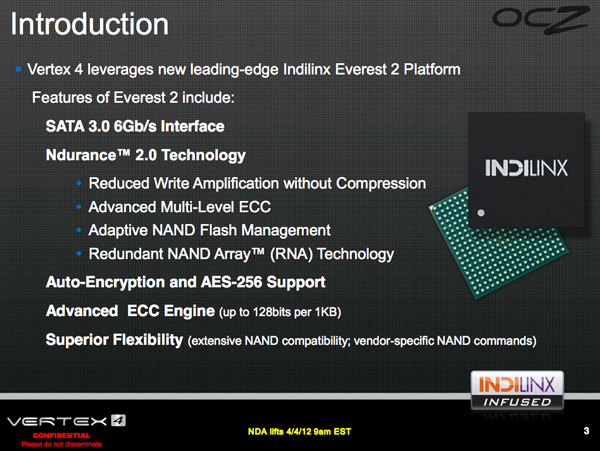
OCZ is also doing some granular manipulation of voltages at the NAND level in order to get the most endurance out of these drives (not all NAND is created equally, adjusting to characteristics of individual NAND devices can lead to more p/e cycles out of the drive). While this isn't really a concern for 25nm NAND on the Vertex 4 today, it is likely a feature we'll see played up with the move to 20nm and for eMLC versions of the drive targeted at the enterprise.
Confidence in reliability is at an all-time high with the Vertex 4 as it ships with a 5-year warranty, up from 3 years with the Octane, Vertex 2 and Vertex 3.


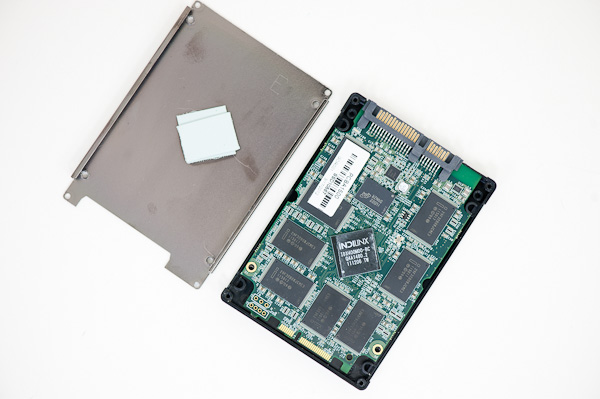
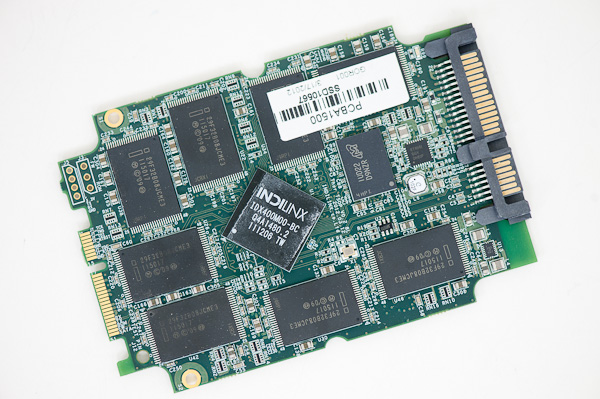
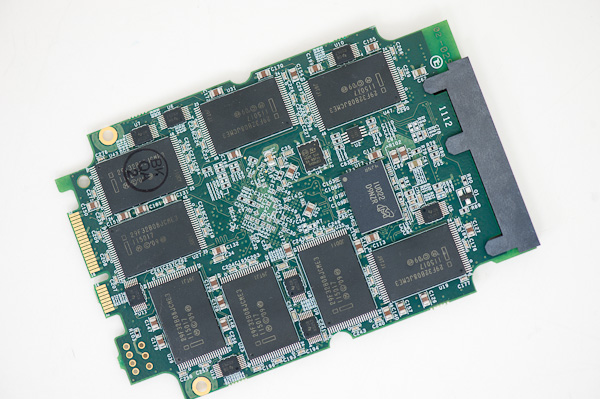
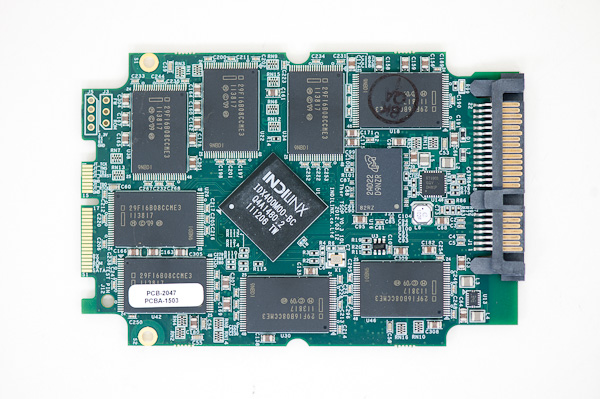
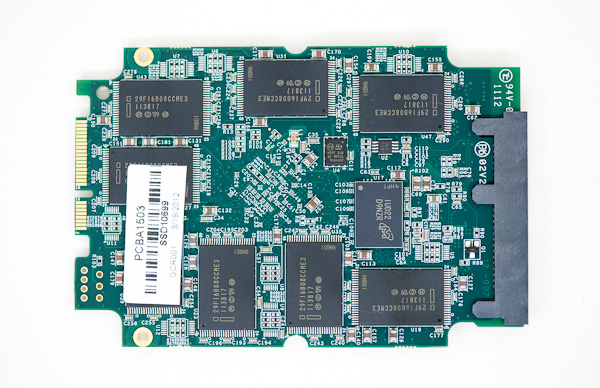








127 Comments
View All Comments
RussianSensation - Wednesday, April 4, 2012 - link
It seems after extensive use and degradation, the Corsair Performance Pro is one of the best, even besting the Crucial M4:http://www.xbitlabs.com/articles/storage/display/m...
meloz - Wednesday, April 4, 2012 - link
What's the deal with using such an enormous SoC built on 65nm process?I can understand OCZ / Indilinx not willing to shell premium for cutting edge 28nm process, but they could have at least used 45nm process.
With a 45nm process the SoC would be a lot smaller, thermal management would be easier (and cheaper), and power consumption would be lower (firmware update or not).
The cost of more modern process is easily balanced by the fact that they would get a lot more chips of a 300nm wafer with 45nm rather than 65nm.
Vertex 4 is a good improvement from OCZ, but they need to get serious about their execution and 'little details' if they still want to exist in another 5 years. Marvell, SandForce and Intel are not standing still and as competition increases the price of such poor decisions will weigh heavily against OCZ.
Ryan Smith - Thursday, April 5, 2012 - link
While we obviously can't speak for OCZ, when it comes to processes do keep in mind that costs escalate with the process. Older processes are not only cheaper because they have effectively reached their maximum yields, but the cost of their development has always been paid off, allowing the fabs to sell wafer runs at a lower cost and still book a profit.For a sufficiently simple device, the additional number of dice per wafer may not offset the higher per-wafer costs, lower yield, and demand-driven pricing. 4x nm processes are still booked solid, and will be for some time.
NCM - Wednesday, April 4, 2012 - link
Firmware "promises" aren't worth the guarantee they're not written on.We buy today's product, not the product there might be in some indefinite future.
rw1986 - Wednesday, April 4, 2012 - link
seems intel NAND would cost more and OCZ buys most of their NAND from Micron I believeKristian Vättö - Wednesday, April 4, 2012 - link
Without knowing the prices, it's hard to say anything. Intel and Micron NAND come from the same fab so the silicon quality is the same. Intel does rate their NAND higher (5000 vs 3000 P/E cycles) and both companies have their own validation processes, so it's possible that Intel NAND is slightly higher quality.It's possible that OCZ sources NAND from several fabs for the Vertex 4. E.g. Vertex 3 used NAND from Intel, Micron, Spectec and Hynix. Micron NAND is available in higher quantity as they own more plants, so that's why it's more common. Price wise I guess they are all about the same, though.
bji - Wednesday, April 4, 2012 - link
Any time a drive has a significant amount of RAM in it, I get a bit worried about the possibility of data loss on power outage. If the drive has the name OCZ attached, this worry becomes a huge concern. I would not be at all surprised if OCZ increased performance in part by reducing durability in the face of power outage.If the RAM is used as a write buffer, then on power outage the data is lost. This is not a problem if the drive correctly reports this state to the operating system - i.e., not telling the operating system that the data is sync'd to permanent storage until it's been written out of RAM cache into the flash cells. But if the drive cheats by telling the operating system that the blocks have been written when they have been stored in its RAM rather than when the blocks have actually made it to the flash cells, then data can be lost despite the guarantee that the drive has given that it can't.
Cheating in this way could make write performance look better, and given that the drive looks particularly good for write performance and has a lot of RAM on board, I am very, very suspicious.
What about testing this drive's durability in the face of power loss?
geddarkstorm - Wednesday, April 4, 2012 - link
That's a good question.However, from the article it sounds like the RAM is mostly being used to prefetch reads, rather than buffer writes.
bji - Wednesday, April 4, 2012 - link
That's Anandtech's conjecture. Even if OCZ told them it was so, it's not proven, as OCZ could be lying to cover the deficiency.FunBunny2 - Wednesday, April 4, 2012 - link
Exactly!! An "Enterprise SSD" with no superCap?? That needs some 'splainin.